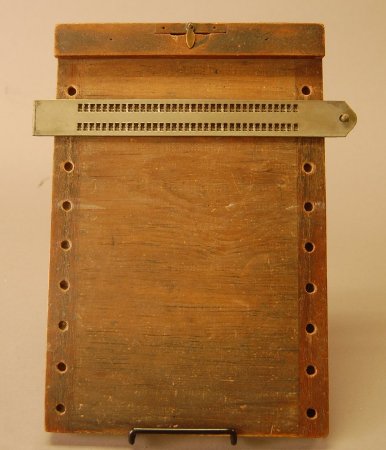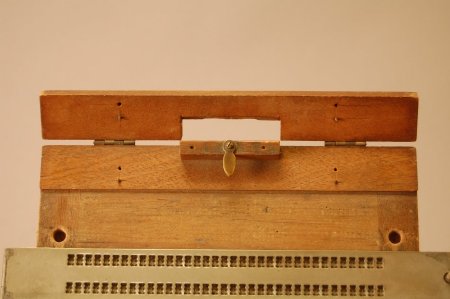Object ID:
2001.26.4a-b
Title:
Large Interlining Frame
Description:
Wooden desk slate; (a) board; two solid wood side rails of darker wood, tongue and grooved to main board and secured by two (2) screws through sides, each rail has nine (9) 5/16" diameter holes bored in a vertical line; wooden full width paper clamp at top of board, hinged with two brass curled piano hinges, cutout in center of clamp for fixed block mounted with brass leaf-shaped clamp lock, clamp has steel teeth both up and down (total of four); stamped on top of left rail behind clamp, "BA"; (b) hinged nickel alloy desk slate for interlining braille, rounded point on open end, curled piano hinge on opposite end; two (2) lines of 35 cells; 1 large blunt pin on front of bottom plate which fits through hole in top frame when closed; two copper pegs riveted on bottom frame to fit holes in the board; "7" stamped on top and bottom frames.
Date:
ca. 1895
Made by:
British & Foreign Association for Promoting the Education and Employment of
Place of Origin:
London, England
Provenance:
The British & Foreign Association for Promoting the Education and Employment of the Blind, founded in 1868, was listing large and small interlining frames for braille as early as 1882. An interline slate allowed the user to write on both sides of a page. By alternating lines from front to back, the braille dots did not cancel each other out, but at the expense of text density.
The "BA" became the National Institute for the Blind in 1914. Braille slates were difficult to find in the U.S. prior to 1900. British slates and braille materials were listed in the annual reports of the Perkins School throughout the 1870s as a potential source, and the school noted that its students used British "tablets" in its 1874 report.
The "BA" became the National Institute for the Blind in 1914. Braille slates were difficult to find in the U.S. prior to 1900. British slates and braille materials were listed in the annual reports of the Perkins School throughout the 1870s as a potential source, and the school noted that its students used British "tablets" in its 1874 report.
Credit Line:
Museum Purchase, 2001.26

